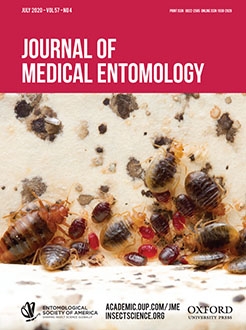Maintenance of laboratory colonies of insects and other arthropod pests offers significant research advantages. The availability, age, sex, housing conditions, nutrition, and relative uniformity over time of biological material for research facilitate comparison of results between experiments that would otherwise be difficult or impossible. A laboratory research colony of Phlebotomus papatasi (Scopoli), old world sand flies, was maintained with high-colony productivity for a number of years, but within a relatively short (4–6 mo) time period, colony productivity declined from over 10,000 flies per week to less than 100 per week. Mites and nematodes were both visible in the larval medium; however, the mites had been present throughout high productivity periods; therefore, it seemed reasonable to investigate the nematodes. PCR amplification of 18S rRNA yielded a clean cDNA sequence identified by BLAST search as Procephalobus sp. 1 WB-2008 (Rhabditida: Panagrolaimidae) small subunit ribosomal RNA gene, GenBank EU543179.1, with 475/477 nucleotide identities. Nematode samples were collected and identified as Tricephalobus steineri, (Andrássy, 1952) Rühm, 1956 (Rhabditida: Panagrolaimidae) based on morphological characteristics of the esophagus and the male copulatory apparatus. Mites (Tyrophagus putrescentiae [Acariformes: Acaridae]) may have played an additional predatory role in the loss of sand fly colony productivity. We hypothesized that the origin of the nematode infestation was rabbit dung from a local rabbitry used in preparation of the larval medium. Colony productivity was fully restored within 3 mo (two sand fly generational periods) by replacement of the rabbit dung from a clean source for use to prepare sand fly larval medium.
How to translate text using browser tools
18 January 2020
Sand Fly Colony Crash Tentatively Attributed to Nematode Infestation
Kevin B. Temeyer,
Kristie G. Schlechte,
Laryssa B. Dandeneau
ACCESS THE FULL ARTICLE
It is not available for individual sale.
This article is only available to subscribers.
It is not available for individual sale.
It is not available for individual sale.

Journal of Medical Entomology
Vol. 57 • No. 4
July 2020
Vol. 57 • No. 4
July 2020
insect colony maintenance
mite
nematode identification
Phlebotomus papatasi
sand fly




